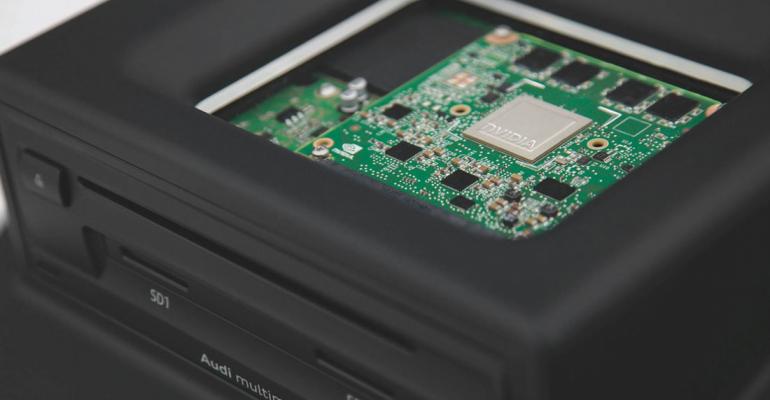DETROIT – NVIDIA, a Santa Clara, CA-based technology company best known as a producer of chips for the video-game and consumer-electronics industry, has set up shop in Michigan as it attempts to grow its burgeoning automotive business.
The Tier 2 supplier’s TEGRA system-on-a-chip superprocessor currently powers infotainment systems for most Audi models and the Volkswagen Golf, but its latest technology opens the door for expanded automotive uses, says Dave Anderson, automotive applications manager.
Anderson says the TEGRA chip traditionally has been used for visual infotainment displays, but now also can power driver-assistance technologies, providing a clear advantage for auto makers that adopt the system.
“It’s more powerful and consumes less energy,” he tells WardsAuto at a recent industry event. “The total performance per watt is less than the competition, and the other benefit we have is it’s integrated.”
Reducing energy consumption is especially important for alternative-powered vehicles such as hybrids and battery-electrics, he says, noting the TEGRA processor’s dual abilities also provide packaging efficiencies.
“We’re solving a problem by providing a powerful computing, yet very energy-efficient platform,” Anderson says. “No other competitors have that ability.”
The TEGRA processor can be swapped out of vehicles as new versions debut, making infotainment and driver-assistance technologies easily updateable. Currently, VW and Audi provide updates with each model refresh, but Anderson says other auto makers that adopt the technology may opt to have dealer-installed upgrades.
Because it’s upgradeable, the system provides cost savings to auto makers, as they only have to engineer the system platform once instead of each time a next-generation model debuts.
“We’re looking at a modular upgrade path, and we already see this happening,” Anderson says. “It allows the OEMs to go out and innovate at the application level and not have to worry about making the (platform) investment.”
The TEGRA chip can run a variety of driver-assistance technologies, including lane departure, traffic-sign recognition, pedestrian detection and collision avoidance. But NVIDIA is working on ways to expand its abilities and is conducting research into areas such as gesture, voice and facial recognition.
Audi recently used the chip to power a semi-autonomous demonstrator car at the Consumer Electronics Show in Las Vegas. Anderson says once in traffic, the car can sense the vehicles ahead and behind it and keep up with the flow via autonomous steering, braking and acceleration.
“That’s a total system they’ve been able to develop with our technology,” he says.
While TEGRA chips currently are relegated to high-end vehicles, with the exception of the VW Golf, the technology is moving downstream. Anderson says VW Group’s Skoda brand plans to use it on the Octavia sedan, and NVIDIA is in talks with other auto makers, including the Detroit Three.
Although he declines to reveal the price of a TEGRA chip, Anderson says it’s used in low-end consumer devices such as the Google Nexus 7 tablet.
“Cost is something that’s always a hot topic in automotive,” he says. “So as we try to marry these (automotive and consumer electronic) design cultures together, we’re really sensitive to cost. Everything we do is done with respect to producing a quality, but competitive solution.”





